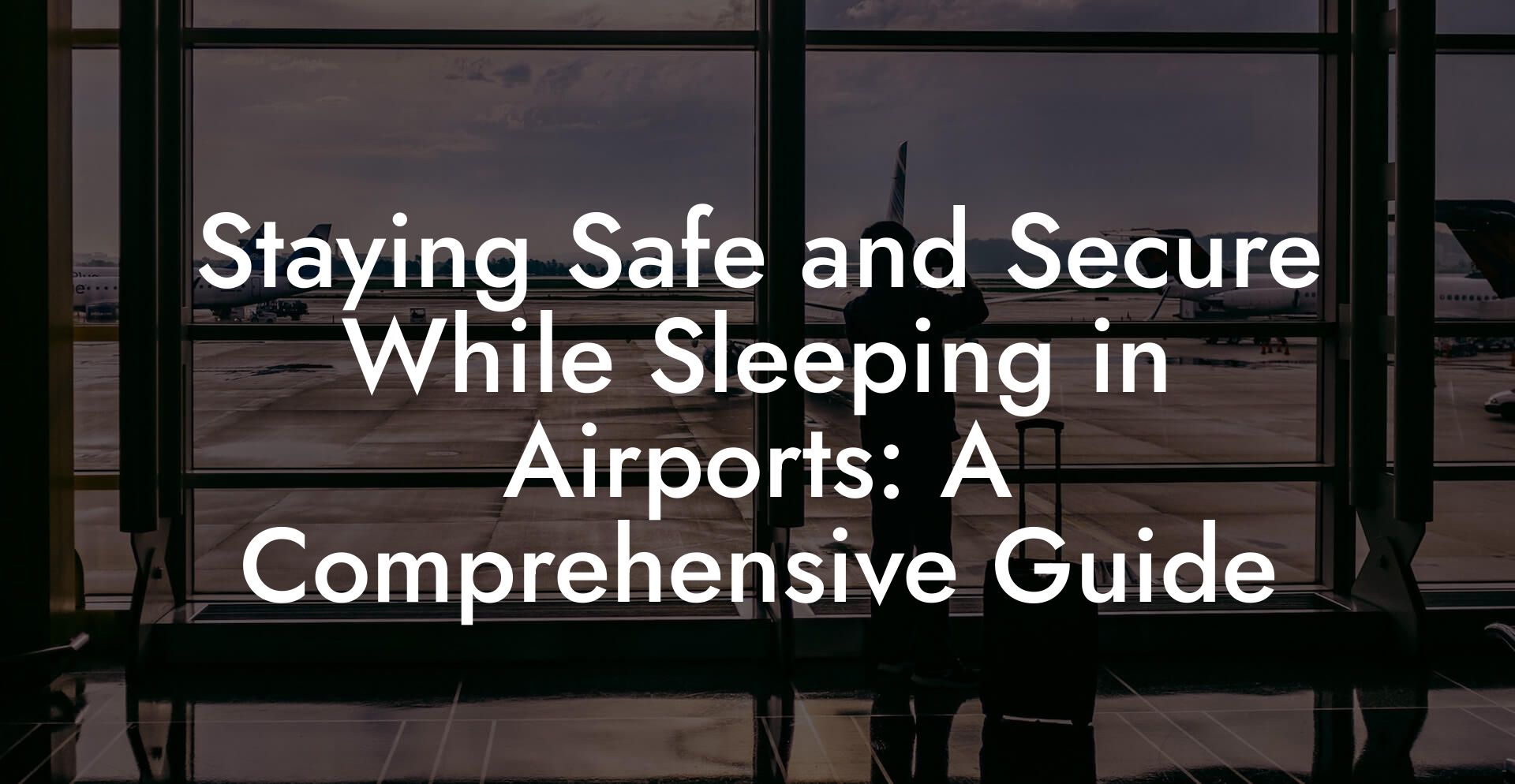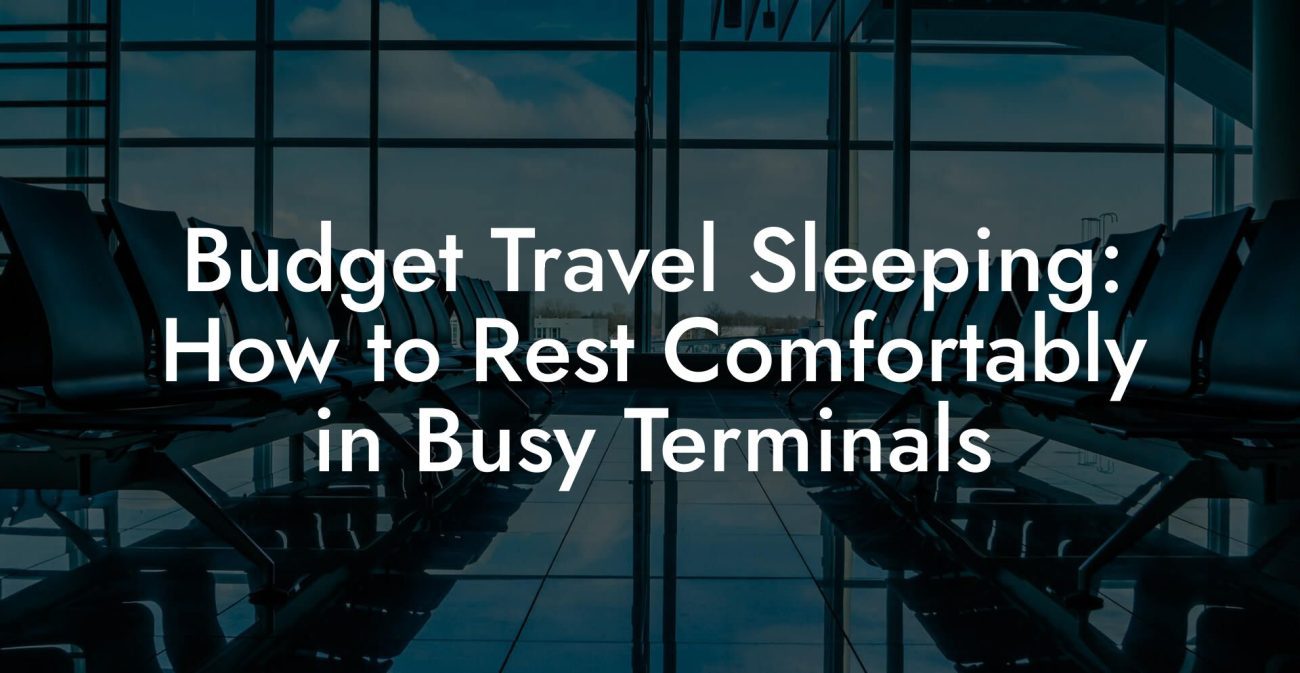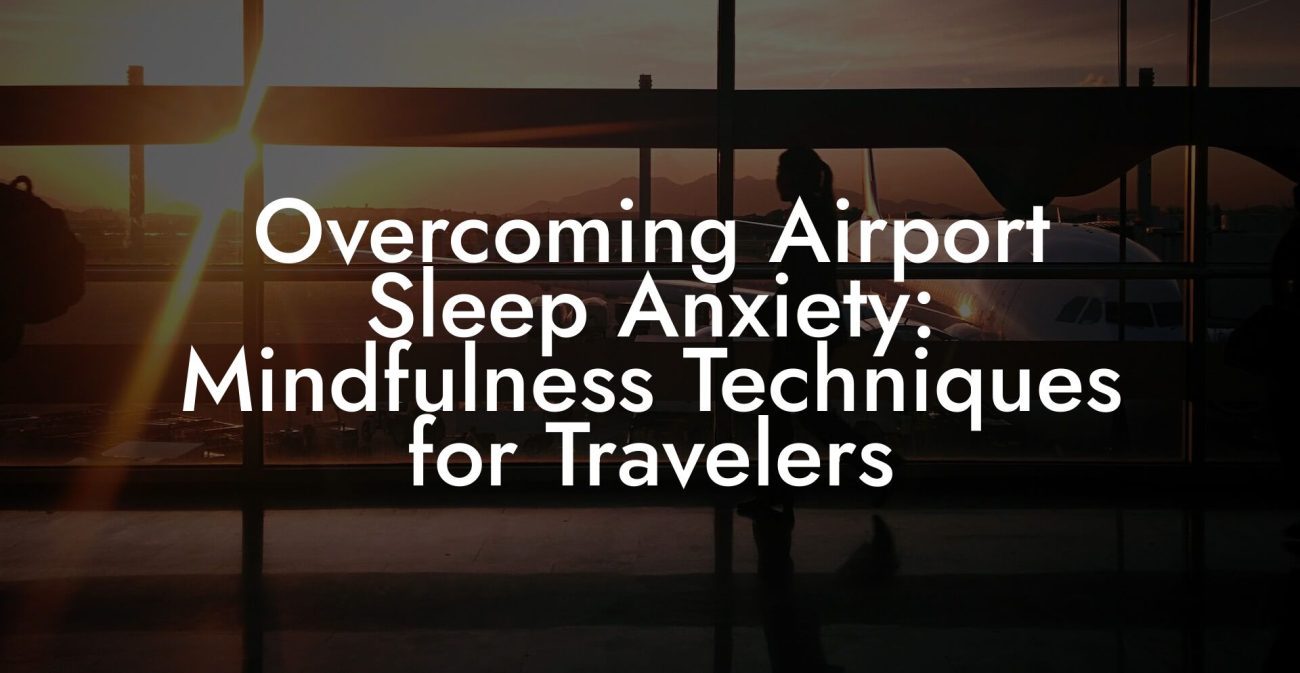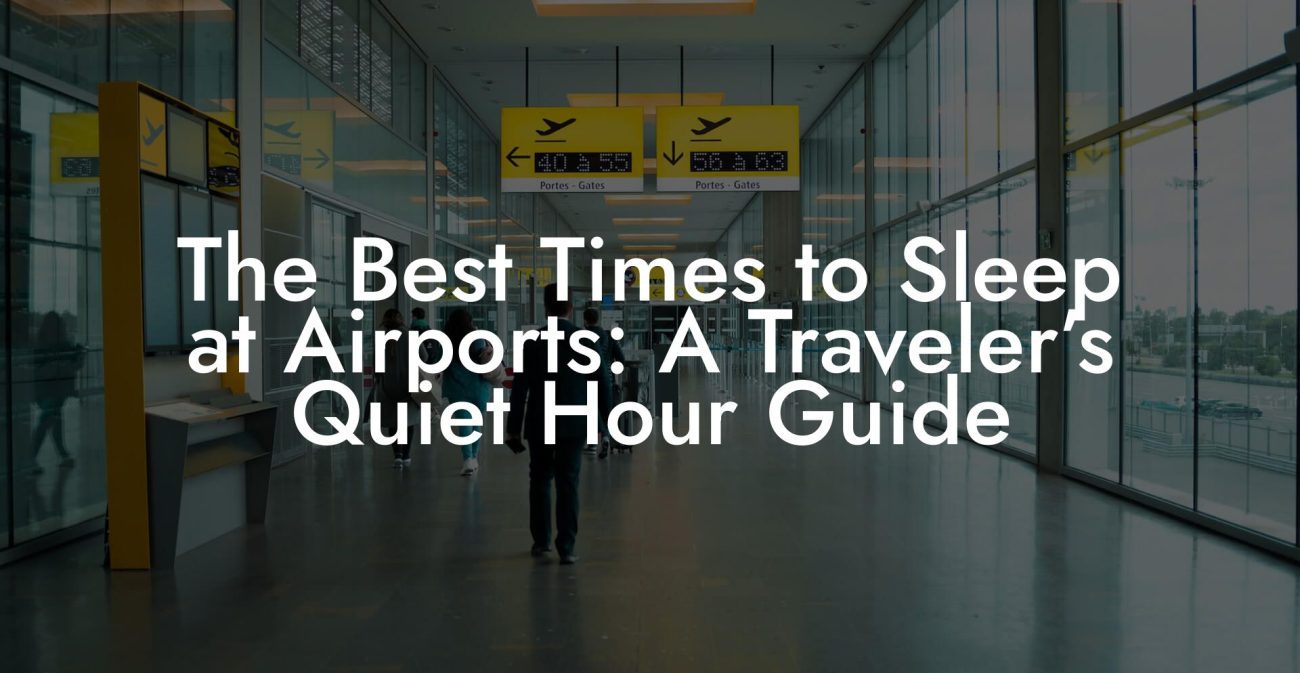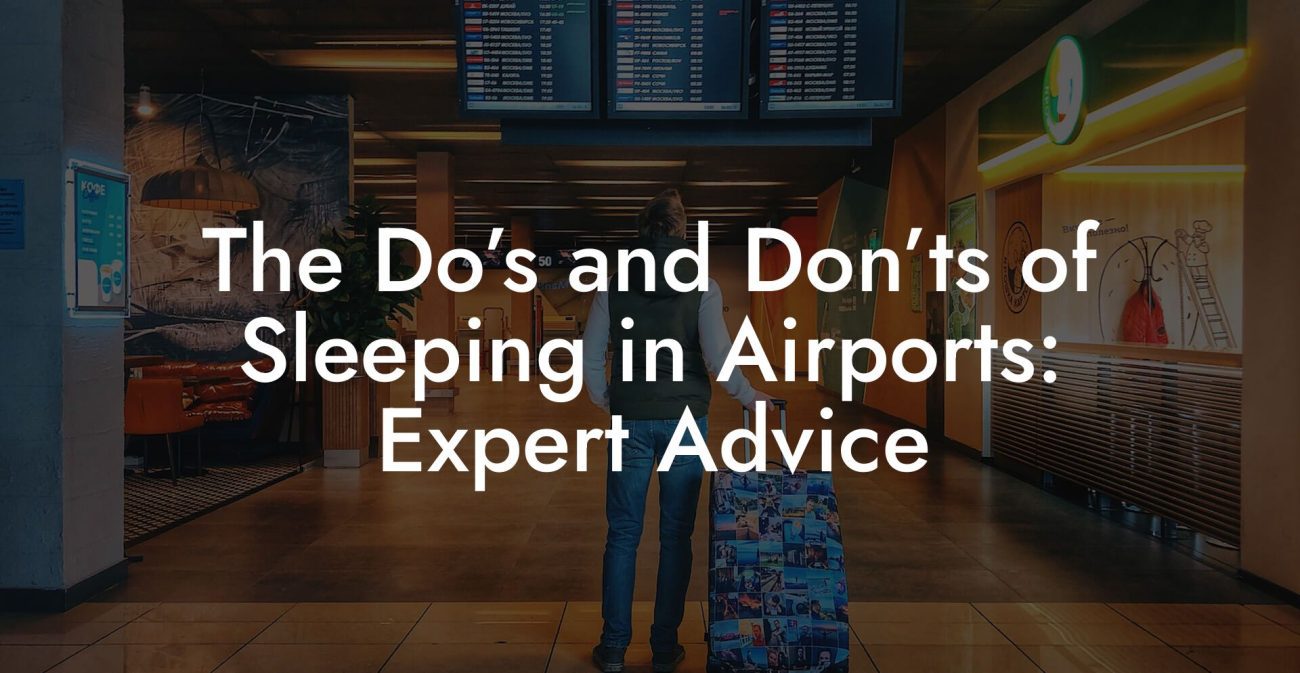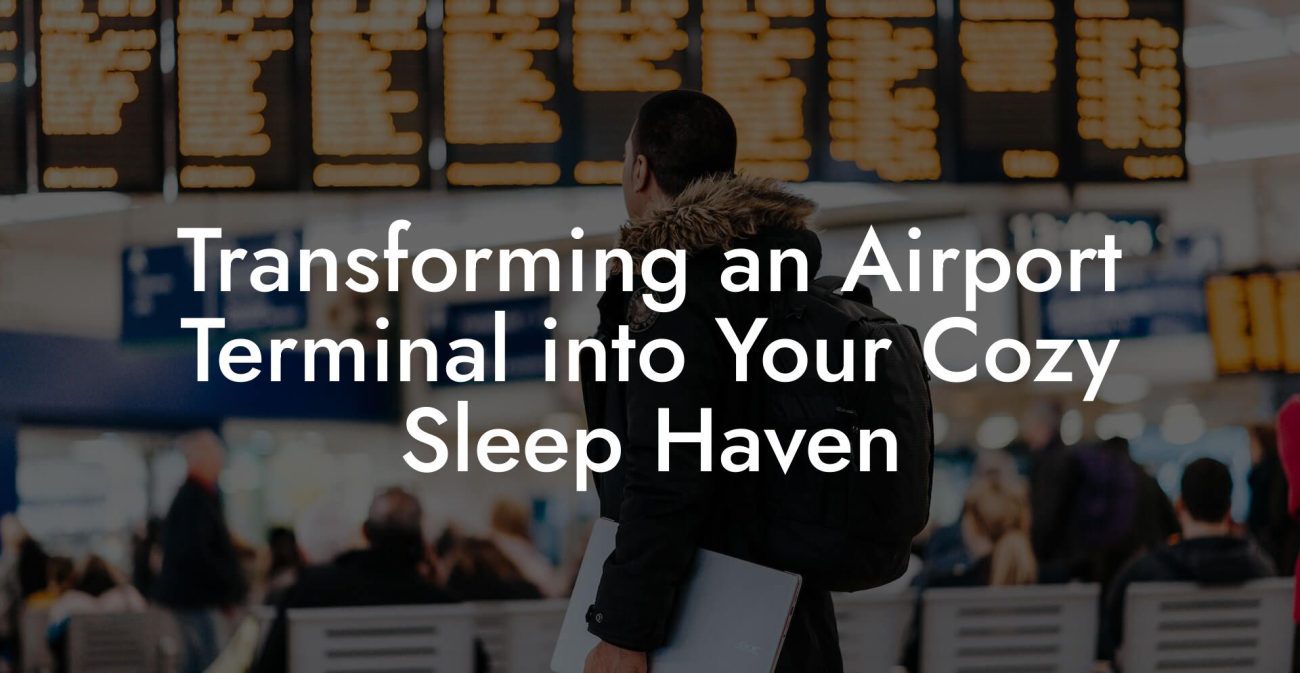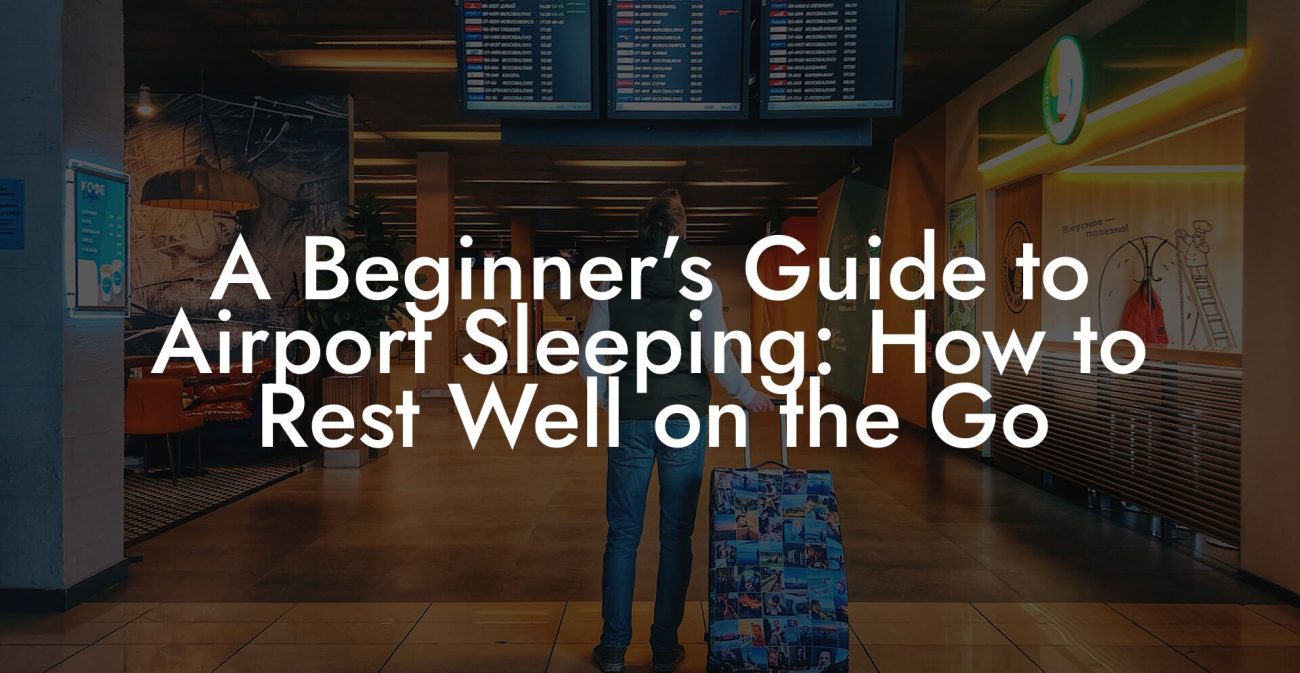Ever found yourself drifting off on a hard plastic bench or nestled among travelers in the terminal, questioning if your next snooze will be as safe as your last boarding pass? Airport sleeping has become a quirky art form—a blend of convenience, spontaneity, and a dash of daring. In this guide, we’re about to unwrap everything about staying safe and secure while sleeping in airports. Whether you’re a digital nomad, an impulsive Gen-Z adventurer, or a thrifty millennial catching a red-eye, this comprehensive guide offers you practical tips, proven hacks, and the ultimate deep-dive into everything from securing your belongings to choosing the perfect airport sleeping pod.
Quick Links to Useful Sections
- Understanding the Art of Airport Sleeping
- Why Sleep in Airports? Exploring the Modern Nomad’s Dilemma
- Safety First: Securing Your Belongings and Digital Data
- Choosing Your Sleeping Spot: Benches, Pods, or Hidden Corners?
- Simplistic Benches and Recliners
- Covert Corners and Secluded Cabinets
- Airport Sleeping Pods: The New-Age Oasis
- Airport Sleeping Pods: Your Personal Capsule of Calm
- Tips for a Restful and Secure Airport Sleep
- The Role of Technology in Enhancing Airport Comfort and Security
- Travel Security Apps
- Smart Lock Systems
- Portable Power and Charging Security
- Personal Safety and Self-Awareness: Staying Alert in Sleep Mode
- Real-Life Narratives: Navigating Airport Sleep Safely
- Resources and Community Support: Your Next Steps
- Building a Personalized Airport Sleeping Strategy
- Step 1: Research and Plan Ahead
- Step 2: Pack Smart
- Step 3: Secure Your Digital Footprint
- Step 4: Evaluate and Adjust Your Sleeping Spot
- Step 5: Establish a Pre-Sleep Routine
- Balancing Comfort with Vigilance: Essential Safety Gear
- Optimizing the Airport Environment: Insider Hacks for a Better Snooze
- The Psychology of Security: Trusting Your Instincts in a Transient World
- Digital Security: Keeping Your Online Life Safe as You Sleep
- Your Journey to Secure Airport Slumber
- FAQs: Staying Safe and Secure While Sleeping in Airports
- Your Next Step: Mastering the Journey to Secure Airport Sleep
Understanding the Art of Airport Sleeping
Airport sleeping is not simply about catching a quick nap between flights—it’s a lifestyle for many. With skyrocketing hotel prices and ever-changing itineraries, countless travelers are turning to airport terminals as their temporary sanctuaries. But before you roll out your travel blanket under that fluorescent light, it’s crucial to understand the nuances of airport sleeping, from airport design and security to the different types of sleeping arrangements available.
Terminal architecture is often both a blessing and a challenge for the weary traveler. While some airports boast quiet corners, secluded lounges, and even dedicated sleeping pods, others are a maze of busy corridors and unpredictable seating arrangements. And let’s not forget the ever-watchful security personnel and the ebb and flow of fellow passengers—elements that all contribute to the complexity of finding the perfect, secure spot to rest.
By blending common sense with insider tactics, you can transform a bustling terminal into your personal resting palette. In the sections that follow, we’ll explore every facet of airport sleeping safety—from personal security measures to the latest in airport sleeping pod technology.
Why Sleep in Airports? Exploring the Modern Nomad’s Dilemma
If you’re wondering why millions now consider airport sleeping a viable option, you’re not alone. For some, it’s an economic necessity, while for others, it’s an adventurous lifestyle choice. Delays, early flight departures, or even an intentional digital detox can all lead to overnight stays at the airport.
There’s also an undeniable allure to spending a night in a space that buzzes with the energy of transient souls and ceaseless chatter from “The Flight Attendant’s” PA system. The airport becomes a melting pot of cultures, ideas, and stories—a place where every sleeping nook has its own narrative, and every traveler is a story waiting to be told.
In mastering the subtleties of airport sleeping, you not only learn to optimize your limited rest but also discover a community of fellow wanderers, each with their own tricks and safety checklists to share. This guide is your gateway to those insider secrets.
Safety First: Securing Your Belongings and Digital Data
While a nap in the terminal might sound like a dream, it’s one that requires a fortress-like approach to your personal belongings and digital identity. In the hustle and bustle of public spaces, maintaining a watchful eye on your stuff is non-negotiable.
The first rule of thumb: always assume that opportunity can present itself in even the most secure environments. Here are some must-do safety measures:
- Keep It Close: Never leave your valuables unattended even for a minute. A slingshot bag worn across your body, filled with essentials like your passport, wallet, and smartphone, can be your first line of defense.
- Lock It Down: Equip your bags with TSA-approved locks and invest in travel security pouches designed to thwart pickpockets.
- Digital Vigilance: With a world where your identity is as valuable as your belongings, use secure passwords, enable two-factor authentication, and consider a VPN when connecting to public Wi-Fi.
- Location, Location, Location: Choose sleeping spots in view of active security cameras or near staff offices. Being in a “visible” area can deter potential thieves.
Additionally, travel insurance can be a lifesaver. It might not stop a theft, but knowing you have a backup can ease the anxiety that comes with airport sleeping.
Choosing Your Sleeping Spot: Benches, Pods, or Hidden Corners?
Not all spots in an airport are created equal when it comes to comfort and security. The decision on where to crash is a pivotal one. Here are the primary options:
Simplistic Benches and Recliners
Many travelers resort to standard seating—benches or recliners found near gates or in waiting areas. These options often provide a utilitarian space for a short nap. However, they come with their share of disadvantages, such as hard surfaces and limited privacy.
Best for those who need a quick power nap without planning an overnight stay.
Covert Corners and Secluded Cabinets
Some airports have separate alcoves or less-trafficked terminals designed to help you catch some shut-eye. These often provide a slightly higher level of privacy but may still be prone to unexpected passersby.
Airport Sleeping Pods: The New-Age Oasis
Designed specifically for the modern traveler, sleeping pods offer a blend of privacy and comfort with enhanced security measures. These compact, soundproof units are equipped with features such as charging ports, adjustable lighting, and integrated alarms. In many cases, the pods themselves have digital key systems and surveillance for added safety.
If budget and availability allow, the airport sleeping pod experience is an upgrade to the usual terminal snooze—an experience that provides not only improved comfort but also substantial peace of mind.
Airport Sleeping Pods: Your Personal Capsule of Calm
Say goodbye to the days of awkwardly balancing on uncomfortable benches amidst the buzz of a crowded terminal. Enter airport sleeping pods. These futuristic capsules are revolutionizing the art of airport sleeping by providing a secure, confined space where you can truly relax.
Modern sleeping pods are designed with the traveler in mind. They incorporate smart technology to protect your personal space—think digital locks, internal monitoring systems, and even climate control. Pod designs vary from minimalist futuristic cells to more homely shrines complete with ergonomic mattresses, charging ports, and ambient lighting. For many, these pods strike the perfect balance between comfort and security.
If you’ve never experienced an airport sleeping pod, prepare to be impressed. Their innovative design not only safeguards your belongings with integrated compartments and lockable storage but also offers a haven away from the hubbub of the terminal. For the budget-savvy adventurer, sometimes even a reserved lounge with pod-like seating can offer a decent alternative.
Tips for a Restful and Secure Airport Sleep
Crafting the ideal airport sleeping experience is all about preparation and a few clever hacks. Here are some practical tips designed to help you drift off safely:
- Invest in a Travel Blanket and Pillow: Compact, lightweight, and often surprisingly cozy, these items ensure better comfort while also providing a subtle physical barrier between you and any prying hands.
- Layer Up Your Security: Use cable locks for your bags, or even a portable safe that can be secured to stationary objects. A hidden money belt underneath your clothing is also a timeless strategy to keep your valuables with you.
- Choose Your Spot Wisely: Aim for areas with a good mix of pedestrian traffic and surveillance. Avoid isolated corners where fewer people pass by.
- Use Noise-Canceling Headphones: These do double duty—shielding your sleep from the constant chatter and alerting you to any unusual noises that might signal trouble.
- Set an Alarm or Use a Timer: In an environment where time can slip away unnoticed, setting an alarm is a must to ensure you’re aware if there’s any activity around you.
- Blend In: Avoid flashy attire and behaviors that make you a standout target. The less you stand out, the lower the risk of drawing unwanted attention.
- Keep Emergency Numbers Handy: Save local emergency contacts and airport security numbers on your smartphone. When traveling internationally, local emergency protocols can differ drastically.
With these tips in your arsenal, you’ll transform the notion of airport sleeping from a risky bet into a thoroughly strategized, secure, and almost luxurious experience.
The Role of Technology in Enhancing Airport Comfort and Security
Technology is your ally when it comes to both enhancing your sleeping comfort and elevating your overall security in an airport environment. From security apps to digital keys for sleeping pods, the modern traveler has an abundance of tools at their fingertips.
Travel Security Apps
A number of smartphone applications are designed to help travelers stay vigilant. For instance, GPS tracking apps can share your location with trusted contacts in real time, while others alert you to nearby incidents or security issues reported by fellow travelers. In addition, many banking apps offer real-time transaction alerts, ensuring you’re promptly notified if anything unusual occurs.
Smart Lock Systems
As airport sleeping pods become more prevalent, so do the technologies that power them. Many pods use smart lock systems that integrate with your mobile device, allowing you to monitor access and receive alerts if your pod is tampered with. These systems often incorporate a combination of biometric and digital authentication, significantly reducing the risk of unauthorized entry.
Portable Power and Charging Security
In today’s digital age, keeping your devices charged is essential. However, public charging stations aren’t without risk—data theft through “juice jacking” is a genuine threat. Invest in a portable power bank and utilize USB data blockers that ensure you only receive power without inadvertently transferring data.
By leveraging the latest tech tools, you can create a robust digital and physical fortress that shields your personal data and provides a more serene sleeping sanctuary in the midst of airport chaos.
Personal Safety and Self-Awareness: Staying Alert in Sleep Mode
Even in the serene cocoon of a sleeping pod or a well-guarded corner, self-awareness remains your best defense. Practicing a heightened sense of situational awareness can be the difference between a restful night and an unexpected breach of security.
Always ensure that you keep a portion of your personal belongings—like your phone and a compact travel wallet—within arm’s reach. Develop a pre-sleep routine that includes a quick scan of your surroundings and re-checking that your bags and devices are secure. Training yourself to be mindful even in moments of relaxation can cultivate an instinctive sense of caution that will serve you well amidst unpredictable airport dynamics.
Moreover, share your sleeping location with a trusted friend or family member via a location-sharing app, so someone always has an eye on your whereabouts. This extra layer of vigilance not only enhances your physical safety but also provides peace of mind while you drift off.
Real-Life Narratives: Navigating Airport Sleep Safely
Nothing illustrates the art of airport sleeping better than the real-life experiences of fellow travelers. Meet Alex—a savvy millennial who turned a 15-hour layover in a bustling international hub into an opportunity for a mini digital detox. With a portable travel safe and a pair of noise-canceling headphones, Alex transformed a less-than-ideal terminal bench into a secure, restful haven.
Then there’s Jamie, a Gen-Z traveler who discovered the magic of airport sleeping pods during a spontaneous adventure. Initially skeptical about the cost, Jamie found that the pod not only delivered a peaceful retreat with adjustable climate settings and ambient lighting, but also went the extra mile on security—featuring smart locks and in-built sensors that alerted airport security of any anomalies.
These stories not only highlight a spectrum of strategies—from the simple to the high-tech—but also underscore the adaptability and resilience of today’s travelers. Whether you opt for a makeshift sleeping corner or decide to splurge on an airport sleeping pod, real-world experiences remind us that effective airport sleeping is all about creativity, practicality, and a solid game plan.
Resources and Community Support: Your Next Steps
The journey to mastering airport sleeping doesn’t have to be a solitary one. There’s an entire community of seasoned travelers, digital nomads, and security enthusiasts ready to share tips, updates, and personal stories. Engaging with these communities can offer you ongoing support and timely advice tailored to your next adventure.
Check out travel forums and dedicated social media groups where stories of epic red-eye recoveries and airport survival tips abound. Websites such as The Points Guy, FlyerTalk, and various travel subreddits (like r/travel) provide updated information on the best airports for sleeping, the newest sleeping pod installations, and innovative security measures that can keep you safe.
Don’t overlook your local embassy or consulate’s travel advisory services when visiting foreign countries. They often provide safety updates and tips that can be crucial during night hours. Likewise, many airports now feature dedicated apps that offer real-time updates on lounge availability, sleeping pod reservations, and other amenities.
Finally, consider investing in a lightweight travel journal or a digital note app. Documenting your experiences not only helps in refining your own airport sleep routine but also becomes a helpful resource for fellow travelers.
Building a Personalized Airport Sleeping Strategy
A one-size-fits-all approach to airport sleeping simply doesn’t cut it. Crafting your personalized strategy involves a mix of planning, technology, and self-awareness. Here’s a step-by-step roadmap:
Step 1: Research and Plan Ahead
Before embarking on your journey, research the layout and available amenities of your transit airport. Identify potential sleeping spots using airport maps available on official websites or travel apps. Make a list of lounges, sleeping pods, or quiet corners based on past traveler reviews.
Step 2: Pack Smart
Include travel essentials like a compact travel blanket, an inflatable pillow, cable locks, and a secure pouch for valuables. Don’t forget tech accessories—such as a power bank, noise-canceling headphones, and a USB data blocker—to shield your devices from unnecessary digital threats.
Step 3: Secure Your Digital Footprint
Prior to sleeping, ensure that all your devices are secure. Update your travel security apps, activate VPNs, and double-check that your connections to public Wi-Fi are safe. A moment’s vigilance on your smartphone can prevent a night of unforeseen complications.
Step 4: Evaluate and Adjust Your Sleeping Spot
Once on-site, take a moment to assess the environment. Is it well-lit and in view of active security cameras? Does it offer quick access to exits? Based on your evaluation, adjust your position accordingly. Trust your instincts – if something feels off, it’s better to relocate.
Step 5: Establish a Pre-Sleep Routine
Develop a short ritual each time you prepare to sleep in a new environment. It might include checking that your bags are secured, setting your alarm, and even doing a quick walk-around to verify no one is lingering nearby. A consistent routine helps calm your nerves and keeps potential threats at bay.
By integrating these steps into your travel plan, you create a dynamic framework that not only optimizes your sleeping experience but also acts as a robust security protocol in bustling airport environments.
Balancing Comfort with Vigilance: Essential Safety Gear
When striving for a comfortable and secure sleep in an airport, choosing the right gear is a game-changer. The perfect blend of comfort and precaution can transform a typically stressful environment into a serene resting spot.
Consider investing in:
- Anti-Theft Travel Bags: These bags come with hidden compartments and RFID-blocking technology to safeguard your data.
- Portable Door Alarms: A small, battery-powered device that alerts you if your partition or sleeping area is disturbed.
- Multi-Tool Keychains: Compact tools that, beyond their practical uses, can also act as deterrents in a pinch.
- Travel-Sized Personal Safety Devices: Items such as pepper sprays (where legally permitted) or whistle alarms that can alert nearby security if needed.
By arming yourself with these pieces of safety gear, you not only enhance your physical security but also build a mindset geared toward proactive protection. Always remember: comfort is vital, but vigilance is your best insurance.
Optimizing the Airport Environment: Insider Hacks for a Better Snooze
Besides personal security, environmental factors play a huge role in how restful (and safe) your airport sleep can be. Here are some insider hacks to optimize your surroundings:
- Scout Out Charging Stations: Identify stations that are in well-monitored areas—these spots usually double as secure resting areas.
- Find the Best Lounges: Even if you don’t have a premium ticket, many airports offer day passes or discounted entry to lounges where security and comfort are both prioritized.
- Layer Your Lighting: Use a portable, battery-operated reading light. Not only does this cut down on the unsettling darkness, but it can also signal to others that you’re awake and aware.
- Keep a Low Profile: Blend in with fellow travelers by keeping your gadgets tucked away and avoiding flashy accessories.
- Leverage Airport Apps: Many modern airports have dedicated apps that, beyond flight information, include maps of quiet zones, sleeping pod availability, and even live security updates.
Implementing these subtle strategies can make the difference between an anxious, disrupted sleep and a serene, well-protected slumber.
The Psychology of Security: Trusting Your Instincts in a Transient World
While gear, apps, and security measures provide a physical shield, the psychological aspect of airport sleeping is equally important. Trusting your gut can be one of the best tools in ensuring a safe experience.
If something feels off, whether it’s an eerie silence or an oddly placed unattended bag, don’t dismiss the feeling. Modern travelers are encouraged to listen to their instincts, as these often pick up on subtle cues that formal security systems may overlook.
More than just a survival mechanism, a keen sense of awareness can also inspire confidence. Knowing that you are alert and prepared transforms the airport from a chaotic space into one where you are firmly in control, making the experience a balancing act between relaxation and vigilance.
Digital Security: Keeping Your Online Life Safe as You Sleep
In the era of constant connectivity, safeguarding your online identity is paramount—especially when you’re in an airport, where public networks can be a playground for cyber miscreants. Here’s how to secure your digital presence:
- Use a VPN: By routing your internet traffic through a secure server, a Virtual Private Network ensures your data remains encrypted and hidden from potential hackers on public Wi-Fi.
- Activate Mobile Hotspots: Instead of connecting to unfamiliar networks, consider setting up a personal hotspot (if your data plan allows) to maintain control over your connection.
- Keep Software Updated: Ensure your smartphone and laptops have the latest security updates and anti-virus protection, reducing vulnerabilities.
- Limit Sensitive Transactions: If possible, avoid logging into bank accounts or sensitive apps while connected to public networks.
The technological aspects of airport sleeping can be managed as methodically as your physical environment. Secure your digital life with the same level of attention you give to your travel gear.
Your Journey to Secure Airport Slumber
Blending the demands of modern travel with a need for rest in unconventional environments may seem daunting, but the confluence of thoughtful planning, cutting-edge technology, and self-awareness transforms the experience into something both safe and restorative. By staying informed, implementing proven security measures, and leveraging community insights, you can master the art of sleeping safely in airports.
Each journey, whether brief or extended, is an opportunity to explore the world on your terms—armed with smart strategies and resilient habits. Here, safety and slumber are intertwined, creating a holistic experience that lets you rest assured, no matter how transient your surroundings.
Picture this: you’re nestled in a sleek airport sleeping pod or a cleverly chosen corner, your gear securely locked by your side, and a curated set of security apps up on your phone. Even amid the collective energy of endless travel, you’ve created a microcosm of calm and control. That’s not just airport sleeping—it’s a testament to your savvy, your resilience, and your redefined understanding of comfort in the modern transit world.
Whether you’re a seasoned traveler or embarking on your first overnight airport stay, this guide equips you with the strategies and insights to prioritize safety without sacrificing rest. Embrace the art of secure airport sleeping and transform every layover into a rejuvenating retreat where peace of mind is always in style.
FAQs: Staying Safe and Secure While Sleeping in Airports
Below are some frequently asked questions to address common concerns about sleeping in airports and using airport sleeping pods, each designed to help you travel smarter and sleep safer.
1. Is it safe to sleep at an airport?
Yes, many airports have dedicated sleeping areas or pods, and with the right preparations—such as securing your belongings and choosing well-monitored spots—sleeping safely at an airport is very achievable.
2. What are airport sleeping pods and how secure are they?
Airport sleeping pods are compact, secure capsules designed for travelers to rest in. They often come with digital locks, surveillance measures, and privacy features that make them far more secure compared to regular seating areas.
3. What safety measures should I take when sleeping in an airport?
Always keep your valuables close, use TSA-approved locks, utilize noise-canceling headphones, set alarms, and choose spots that are visible to airport security. Additionally, secure your digital devices with proper software and avoid using public charging ports without a data blocker.
4. Can I trust public USB charging stations?
Public charging stations can pose risks such as data theft. It is advisable to carry a portable power bank and use USB data blockers to protect your devices.
5. How do I select the best sleeping spot in a busy terminal?
Look for well-lit areas with clear sightlines to security cameras, avoid isolated corners, and if available, opt for designated sleeping areas or pods that offer additional security features.
6. What role does technology play in airport sleeping security?
Technology such as travel security apps, smart locks, VPNs, and digital authentication systems in sleeping pods enhances both physical and digital security, providing a safer resting experience.
7. Are there any cost-effective options to improve airport sleep security?
Absolutely. Simple investments like anti-theft bags, travel security pouches, portable alarms, and low-cost travel accessories can go a long way in boosting your safety during an airport sleep.
8. How can I ensure my digital devices are safe when sleeping in public areas?
Use a VPN, connect to trusted networks or set up personal hotspots, enable two-factor authentication, and keep your device software updated to safeguard against cyber threats.
9. Can airport lounges be a better option for overnight stays?
Many airport lounges offer enhanced security and comfort, making them a great alternative to free seating. Even if you’re not eligible for complimentary lounge access, day passes or discounted access can provide a more secure sleeping experience.
10. Where can I get up-to-date information on the safest airports for overnight stays?
Online travel communities such as FlyerTalk, travel websites like The Points Guy, and dedicated airport review apps frequently update safety ratings and sleeping options for various airports worldwide.
Your Next Step: Mastering the Journey to Secure Airport Sleep
The world of airport sleeping is dynamic—a blend of ever-evolving technology, practical safety strategies, and the adventurous spirit of travelers who dare to redefine rest. You’re now equipped with the comprehensive insights needed to transform a hectic layover into a secure, rejuvenative experience.
Remember, every journey is unique. Whether you rely on the high-tech security of sleeping pods, create a comfortable nook amongst the terminal buzz, or take advantage of cozy airport lounges, the key is preparation, self-awareness, and an unwavering commitment to your personal safety. By integrating these practices into your travel routine, you ensure that no matter where your next flight takes you, your well-being is never compromised.
Step into your next adventure with confidence. Embrace the seamless fusion of safety and comfort that transforms airport sleeping into a sanctuary of rest. Your journey towards becoming a master of secure airport slumber begins now—so pack your gear, fire up your security apps, and make every layover your personal oasis of tranquility and control.
Useful Interruption: Dive deeper into the world of airport sleeping guides with our most popular sections. If there is anything you think is missing or anything you would love for us to write about, just give us a shout.
- General Airport Sleeping Guides
- Travel Gear & Equipment Recommendations
- Regional and Airport-Specific Guides
- Airport Sleeping Pods & Reviews
- Health, Safety, and Comfort Tips for Airport Sleepers
Last week, I decided to try the world-famous "airport sleepover" experience. Imagine this: I'm lying on a bench in Terminal C, surrounded by suitcases that have seen more of the world than I ever will, and a PA system that sounds like a karaoke machine on a sugar rush. I pull out my travel pillow—which, by the way, is more like a sad deflated balloon—and declare, "Tonight, I’m the king of this terminal!"
Soon enough, fellow travelers become my unexpected audience. One guy, fresh off a red-eye, whispers, "Hey, do you think if we sleep long enough, we can catch our flight in our dreams?" I reply, "Sure, and maybe I'll even get an upgrade to first-class in my nap!" The airport lights flicker like a disco ball, and every time someone announces a delayed departure, it’s like a punchline to our impromptu stand-up routine.
As I finally drift off, I dream of a world where boarding passes are like VIP tickets to the best sleepover party ever—a party where the only baggage is the laughter you carry with you. Waking up, I realize the airport is still the same, but I now hold the honorary title of "Terminal Comedian," a title I wear with as much pride as my permanently mismatched socks!

